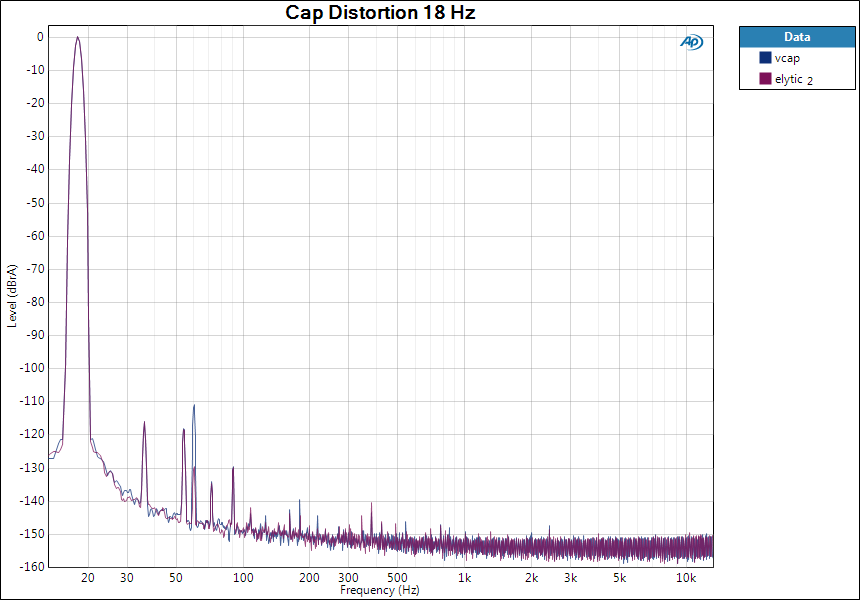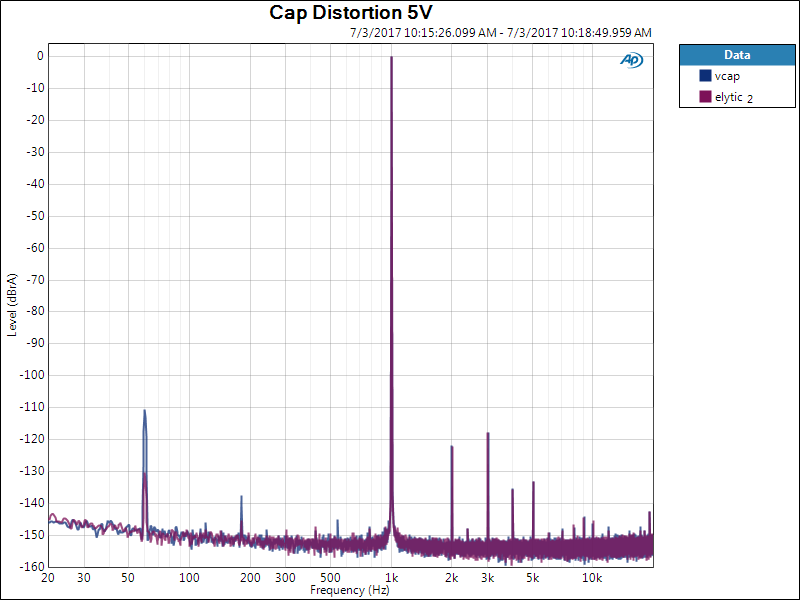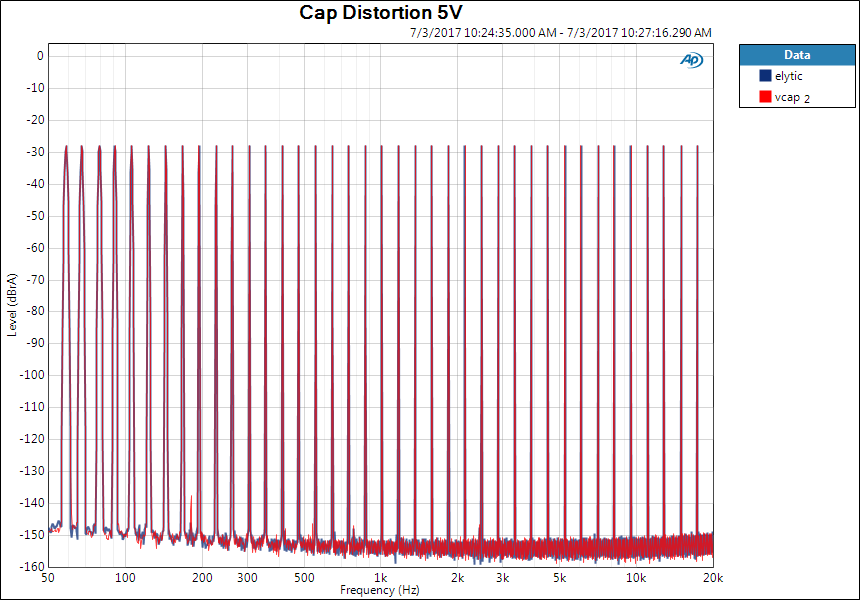Capacitors are probably second on the list of snake oil science peddled to audiophiles, trailing only wire in lack of actual relevant data (either controlled listening tests or electrical tests showing effects above plausible audible thresholds) to back up remarkable sonic claims by their sellers and eager buyers. What elevates these claims to “remarkable,” and thus demanding VERY solid proof before being taken as anything beyond fantasy?
First, a historical aside: the cap craze really took off in the 1970s with (as usual) Jean Hiraga at the origin. The publication of Jung and Marsh’s “Picking Capacitors” article in Audio brought the issue to the attention of mainstream US audiophiles, despite having no relevant experimental data for coupling caps nor any actual listening data to back up the Fear Uncertainty Doubt that the article was meant to create. The article did serve the purpose of launching several boutique capacitor companies, peddling expensive remedies to the newly “discovered” audiophile plague.
Later publications by Cyril Bateman are often cited as plausibility arguments for claimed (but not demonstrated) audible differences between different capacitors used in coupling applications. However, the Bateman articles use test conditions that are more suitable for crossover capacitor applications than coupling, and indeed in speaker crossovers, some of the capacitor imperfections can edge toward audibility. But for coupling caps, Bateman’s analysis is largely irrelevant.
And then a sociological aside: one major reason for the wire craze is that it takes absolutely no knowledge to swap wires, just a credit card. In fact, knowledge here is a detriment to the “fun” of applying exotic “solutions” to problems that only require simple and inexpensive solutions. Capacitors are not far behind- there is the additional barrier of having to solder, but beyond that, it takes no knowledge to read internet reviews, whip out a credit card, and swap in an expensive component with a good story. Follow it up with uncontrolled listening with a pre-existing bias and no actual knowledge to clutter up things, and you have a wonderful story to tell people on the Internet.
When I built a little box which allowed the ears-only comparison of a cheap electrolytic cap and a very expensive Teflon film cap used for coupling (see the Bastard Box section of my article “Testing One, Two, Three” available here), I couldn’t hear a difference. Nor could any of the audiophiles who tried the Box themselves. Perhaps we’re all deaf to the claimed obvious differences? Or maybe there just aren’t any. In this short post, I’ll look at some objective evidence.
First, let’s do a quick technical analysis. A coupling cap by definition has impedance (dominated by its reactance) which is small in magnitude compared to the load impedance. Putting some numbers on that for a typical case, we start with a load impedance of 100k, not atypical for a tube or FET amp stage. A typical value of coupling capacitor for this situation is 1uF, giving an f3 of about 1.6 Hz. Note that this is more than a decade below the lowest audio frequencies of interest. At midband (1 kHz), a 1uF capacitor has a reactance of about 160 ohm, which certainly fits the criterion of “small compared to 100k.” So only about 1% of the signal voltage would appear across the cap.
At 20 Hz, the capacitor has a reactance of about 8k-ohm, so applying the voltage divider equation, we see that there’s a loss of 0.6 dB or so, the voltage then being dropped across the capacitor’s reactance. And a bit under 8% of the voltage is thus across the cap. So let’s first look at distortion at low frequencies.
The reference cap is a 1uF 600V V-Cap Teflon super-expensive (about $300 each) audiophile-grade whatever. The other cap is a pair of 2.2uF 35V cheap aluminum electrolytics connected in series, positive-to-positive to form a bipolar electrolytic. Total cost, about 25 cents. The caps were between the 50R source unbalanced analog output of an Audio Precision APx-515 set to 5V out, and the AP’s unbalanced 100k input. I set the frequency to 18Hz, just to keep the third harmonic separable from any 60Hz pickup.
Here’s the results (0 dB = 5V):
Yup, they overlay one another perfectly, with one exception: the larger size of the V-Cap means more hum pickup, nearly 20 dB worse, in fact (reversing the cap connections had negligible effect). So at least for low frequencies, there’s no performance penalty to spending about 1000% less and perhaps even a bit of advantage.
What about at midband? After all, everyone knows that electrolytics sound murky, right? Could it be the claimed ESR or dielectric absorption, or dissipation factor? From a technical point of view, none of those make sense since the ESR is a vanishingly small contributor in the voltage divider equation, DA is a linear phenomenon which is a worry for DC applications (this isn’t), and DF is likewise buried in the voltage divider, even in severe cases. But what does experiment tell us?
Let’s up the frequency to 1kHz, smack in the midrange, where the capacitive reactance is several hundred ohms, even smaller with respect to the load impedance.
Huh, they still overlay except for the additional hum pickup from the V-cap. There is no distortion advantage whatsoever for the $300 capacitor compared to the 25 cent capacitor in a coupling application. Perhaps those pig-headed engineering types are right about using dull things like voltage divider equations and Maxwell’s equations to select components?
Now, I can hear the sniffy dismissal from Fourier deniers: “These are static signals and not a difficult test. Music is much tougher.” Well, first, bullshit, the signal is constantly changing, and in half a millisecond, it sweeps every value between +7.07 and -7.07 volts. Hardly “static.” But hey, just because it’s so easy to do, lets throw a really complex signal at it, like… oh, I dunno, maybe a 42 tone cluster?
Surprise, surprise, there is not a damn bit of difference except, again, for more noise pickup by the expensive cap. No garbage between tones, no intermodulation.
Now, there may be reasons of reliability to use a film cap instead of an electrolytic for coupling, but there is nothing in the electrical signal which can benefit and as we can see, the larger physical size of the audiophile cap is an actual detriment (though to be fair, a small one). In some circuits, the large size could potentially create more degradation by unwanted stray coupling to other parts of the circuit, so this is in that sense a best case. Nonetheless, if one is to claim audible improvements here, the claim is even more extraordinary since it involves spooky signals undetectable by instruments with resolution and sensitivity several orders of magnitude better than human ears, using test signals far more demanding than music.




!!!!!!!
How I recognise the symptoms! British crime writer Dick Francis formulated it thus: “Entrenched beliefs cannot be altered by facts.” Well-written, hopefully it will make a dent in the tinny armour of self-proclaimed know-alls, using that zenith of reliable analysing/measuring tools, the hallowed EAR. From a 60+ year experienced E E – but hey! What do we know ….
“If it measures good but sounds bad, you are measuring the wrong thing” – Daniel von Recklinghausen. This essay is yet another objectivist argument in the everlasting feud between objectivists and subjectivists in audio.
A cheap Best Buy transistor receiver may have THD of 0.02%, and state-of-the-art SET 15%. Following your argument, the audiophiles should ditch their SETs and rush to Best Buy, saving a lot of money on the way.
THD is not everything in audio distortion. In fact, harmonic distortion is subjectively benign. Examples of horrible distortion that will not be revealed by harmonic analysis are those caused by cold joint, leaky capacitor, or scratching voice coil. Several types of capacitor distortion, such as flicker or electromechanical transduction, may belong to this type.
The noise on your graph at -150-160 dB may actually be the area where real differences between mediocre and superior sound reproduction reside.
Since we don’t listen to pure tones, the only adequate way to evaluate reproduced sound is by listening. Some may hear things better than other. Yes, this is subjective, but so far there is no objective alternative. Rephrasing what you wrote, objectivists should come up with better tests, or shut up.
Depends on your goal. If what you want is an effects box, an SET is an inefficient way to do it, but it will give you an effect. If you want the enjoyment of having a 1930s technology, analogous to driving an antique car, ditto, an SET can be a lot of fun in that respect.
If you want to make a small signal bigger without altering it, SETs are not a good answer. The assertion that stuff at -150dB has audible significance begs for solid evidence. When you get some, I’ll be interested in hearing about it.
You can look at it the other way:
The assertion that stuff at -150dB does NOT have audible signidicance begs for solid evidence.
You sound like a newcomer to the field of high quality sound reproduction. If you listen enough, and read enough reviews, you will notice that resolution of micro detail is what distinguishes a superior reproduction system from a mediocre one.
Human hearing threshold is in excess of -150dB amplitude referenced to 80dB normal listening level:
http://hyperphysics.phy-astr.gsu.edu/hbase/Sound/intens.html
Yes, I’m a newcomer to high quality sound reproduction. That must be it. 😉
Oh, and your reference does not say what you’re claiming. And it shouldn’t because that’s likely a math error on your part. Threshold for humans is about 0 dB, for very young ears in a special chamber, which is 80 dB below your example number, not 150 dB. A super quiet room will have a background noise level of +20 dB or so, and the quietest mikes capable of recording at your 80dB example will have an intrinsic noise of +5dB or so.
You may be confusing decibels of amplitude and power.
No. dB SPL is a well established unit.
See Part 2 of this post. Come back when you have evidence.
SY,
knock em dead,… LOL
Dan
Very interesting write-up. I think you’re spot on with your explanation of the factors that lead to people replacing basic elements like wire and capacitors in their sound systems instead of focusing on the active components that usually affect the sound more substantially.
Great article and I see it has rufled a few feathers. I’ve always been a bit dubious about expensive capacitors, they seem like just another thing to sell to people. I’ve just made a buffer and all I could find in my scrap box for the output coupling caps was some old 250V 47uF electrolytics. Put them in and you know what, it sounds great! Not measured it yet, but I’ve used that very special deveice – my ear!
Hy SY, being engaged in audio since the late sixties I agree 100% with your explanations. Sadly contributions like the ones from SSE2 are dominating worldwide forum discussions. Permanently repeating BS does not make it any better. I am fed up with these eternal discussions between “objectivists” and “subjectivists” and so decided after 10yrs of membership to close my account at DIYAUDIO.com
One of my hobbyhorses is distinguishing between “objective-subjective,” which in audio tortures the actual meaning of these words, and “rationalist-irrationalist,” which is more accurate.
“If you have to peek to hear a difference, you can’t hear it. If you don’t have to peek to hear a difference, you can hear it.”
Love it! I’m thinking the technical arguments may be counter productive. When stuff goes over the head of a zealot, their reaction is denial.
G’evening, Sy. I’ve long held that what-is-important in choosing capacitors is a set of 5 main items…
[1] Proper values
[2] Solid physical construction
[3] Some evidence of long-term stability
[4] Reasonable price
[5] Compactness consistent with enclosure/circuit-board constraints.
While your example of back-to-back electrolytics used a particularly anything-but-linear (expectations) situation … in reality such a zero-crossing-nightmare configuration is employed ALL the time around the globe, for a huge list of applications.
I feel sheepish admitting having fallen into the endangered-unicorn-fetlocks capacitor substitution game in my youth. However, apparently quite unaware that I was building my own A, B, C, X, R (randomized) box to test things, looks like you did too! (LOL)
I came forth intensely unamused … at being able to hear absolutely NADA with all kinds of interstage coupling capacitor substitutions. Didn’t matter one iota, so long as criteria 1 thru 4 were adhered to. I really did note the “confirmation bias” problem… that when telling Authorized and Documented Golden Ear blokes (exclusively male, ho, ho, ho.) that switch selector “B” had the sintered unicorn-and-micronized-teflon silver-foil caps with gold leads … invariably, and UNERRINGLY, they’d profess profound hearing differences.
With private glee, I hadn’t the heart to tell them that “B” was really “R”, for randomized, and every time they selected it, a perfectly random substitution would be made.
Anyway…
This comment might get deleted due to length.
Or apostasy. Hermeneutics… Yew wands. Silver and gold.
GoatGuy – as known on the forums.
Hi SY, it is always funny to me reading myths about capacitors. It seems to be an endless story. What I see is that some people knowing almost nothing of EE and specifically of capacitors discuss subjective results of so called hi-end audio equipment. If you look into some high priced and known for sound quality gear you will find standard caps, often WIMA. Of course there are some few brands which use the copper teflon V-Caps at a horrible price.
My opinion is that when a high quality cap was used AND the circuit is good then audible differences are not evident to a human ear/brain system. Funny too that loudspeakers make the most impact to sound quality and what should a cap do wrong in comparison? Funny further that SET amps with low watts create lots of harmonics and some people find that good sounding. Last not least, audio source like vinyl LP and CD. If hi-end fans would know through how many audio transformers, compressors and op-amp stages the signal went, they should be scared. Finally, personally I do not discuss capacitor sound impact nor do I test on it. As stated above, if the cap is good and the circuit too, the sound is allright.
Found your [bench testing] very reassuring, as I’m considering “Panasonic polyester film” for use as vacuum tube plate coupling capacitors. I’m nearly 70yrs young, and have incorporated many different type capacitors in the [signal path] over the years, and never experienced any problems during my own bench testing.
The only place I’ve had to pay attention to capacitor [types], is when designing today’s SMPS circuits.
Funny in the mid 80s I worked for Sun stereo (midfi) not sure if Nelson was working for them then. We would meet with the sales people from the Uber high end store and they would bore us for hours over every exotic part they were pushing – when they discovered our gross sales were 4-5 times greater we got stuck with paying for the pizza.
Bill
Testing capacitor with little box with your circuit then measure and listening, it would be fair if testing capacitor with recomended audionote set with speaker and change the blackgate, and other boutique cap then measure and listening, and it must be interesting for me to know the result , if someone could experiment, change all the the capacitor in supply, coupling etc all of them with standart ordinary cap and how it measure and sound. Hope some one can tell the result and impression, by objective numbers and subjective nonumbers.
If Audionote (or you) want to donate the stuff needed for the test, I’ll be happy to do it and post the procedures and results.
I am NOT going to spend my own money chasing elves.
I definitly agree with all that!
Being a long-time professional electronics servicer, with over 4 decades of experience, I have to wonder where all the hype and obsession comes from.